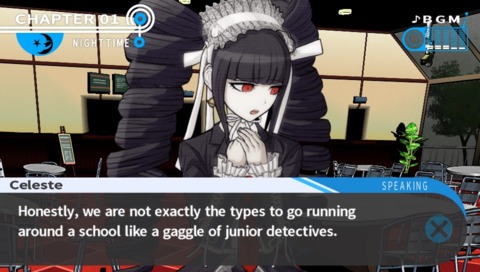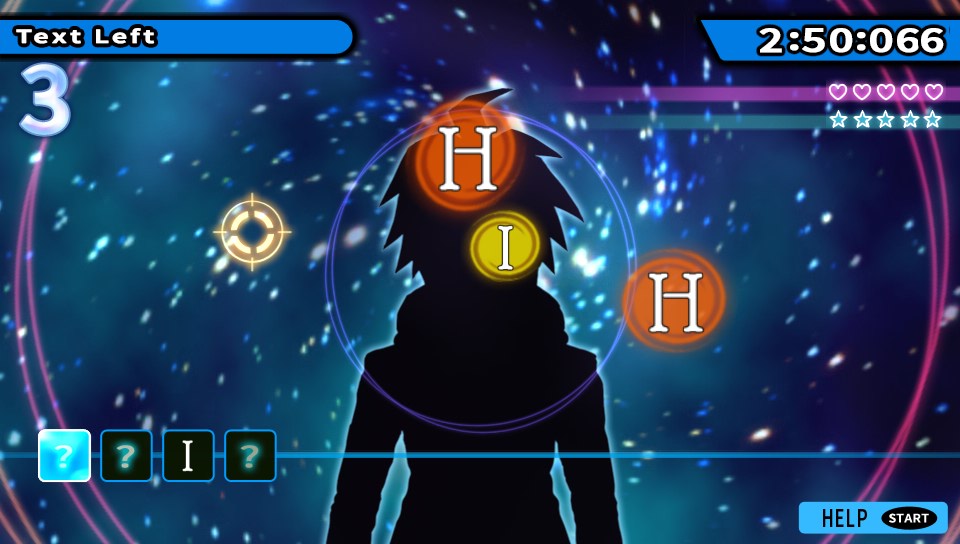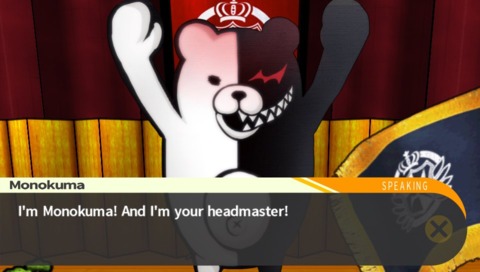A group of people have been locked in a building, and the only way out is to kill one another. To most people, that sounds like yet another predictable entry in the Saw movies. But it's also part of "escape the room," a surprisingly lively subgenre of games familiar to players of the visual novels 999: Nine Hours, Nine Persons, Nine Doors, Zero Escape: Virtue's Last Reward, and others. Danganronpa: Trigger Happy Havoc even comes from Spike Chunsoft, the same developer of both 999 and VLR. This game happily follows in the genre's footsteps--sometimes for better, sometimes for worse. If you're looking for a narrative-driven experience unlike just about anything else out there, Danganronpa delivers handsomely and weirdly.

Danganronpa takes place in Hope's Peak Academy, an elite school for elite students. Only a select few are admitted every school year, and each must be the best of the best. In Danganronpa's world, these pupils are deemed ultimates. Sayaka Maizono, for example, is the "Ultimate Pop Sensation," Leon Kuwata is the "Ultimate Baseball Star," and Chihiro Fujisaki is the "Ultimate Programmer." Players are cast as Makoto Naegi, a humble but affable youngster who is, at first glance, unexceptional in every way. He's the "Ultimate Lucky Student," as he's been granted the opportunity to attend Hope's Peak Academy, despite his lack of special skills. As each student arrives at the school, they pass out. Upon awakening, the students introduce themselves to one another before meeting the master of ceremonies, Monokuma. He's a, uh, talking and murdering bear. (That's not really anymore ridiculous than the talking doll from Saw, to be fair.) The group has the option of living out the rest of their lives in the school, or "graduating" by killing one another. If you can get away with murder, you can leave.
From there, when you're not tapping through dialogue, the game transitions to a relationship simulator of sorts. Looking around unlocks tokens to buy presents from the school's store. These presents, if used appropriately, can advance your relationship with the other students. (But not in a sexual manner, from what I saw.) Sadly, with some rare exceptions, you don't learn much from these moments that wouldn't arrive via the main storyline. It's mostly a means to unlock new abilities for the courtroom portion of the game and gathering trophies. The lack of meaningful insight into the characters meant I'd often find myself picking which one to spend time with at random, simply hoping to advance the storyline to the next major beat. There is no real upside or downside to who you spend time with, as the story does not adjust based on your choices, and the abilities aren't necessary to complete the courtroom segments. It's a missed opportunity for a game that is, largely, all about its story.
The main storyline does spend plenty of time with the characters, though. And while Danganronpa has moments of shocking violence, unlike your typical horror, it's not entirely about the gore. In fact, Danganronpa even swaps the color of blood from red to pink. What makes Danganronpa different is context. The many quiet moments with each character give each death a sense of weight and loss, and while you should never grow attached, you will. Learning about Byakuya's ambitions for greatness as a means of living up to to his family lineage or Hina's secret desire for donuts in moments of weakness means each chapter and each death is not just a bodycount. Many of the characters are purposely unlikable, but their intentions are, often, logically justifiable and create a wild, unpredictable dynamic that unfolds over the game's 20ish hours.
As one might expect, it doesn't take long for things to go awry. Not everyone is content to stay inside for the rest of their lives, and murder(s) come quickly. When a body is discovered, the game transitions to an Ace Attorney-style investigation mode. Searching the world around you is easy enough, as tapping triangle brings up all the interactive parts of the environment. You can't really fail, as the game's story won't move forward until you have all the evidence that's available, which are stored in your inventory as "truth bullets." (As silly as this sounds--and it's definitely silly--the game's title is derived from the Japanese words for bullet and refutation.)
After you've clicked on everything, Monokuma will ask everyone to head to the school's basement, which happens to house a circular courtroom. (It has a bath house, so why not?) These hour-long unravelings of each murder(s) is where the meat of Danganronpa's gameplay takes place, and happen via a series of logic-based minigames. The most common one involves listening to a conversation between several different characters and pointing out a contradiction with either a piece of evidence from the crime scene or within the dialogue itself. These are the most fun, working as little riddles to tease out a new strand of truth. Every once and a while, there's a shooting gallery of letters used to play a game of Hangman, and when you're trying to completely break an argument, a quick rhythm game appears. Neither are very fun. However, every case closes with you arranging an elaborate comic outlining the murder from start to finish, which are easily the game's most enjoyable puzzles. A dozen more of these instead of a single game of Hangman would have been great.

I found it hard not to scratch my head during the courtroom sequences, too. Danganronpa desperately wants to make its story interactive, and does so with a false sense of drama. The game trips over itself so your character is the one to solve everything, even if others have already figured it out and have zero motivation to keep it from you. Plus, for whatever reason, you have a health bar? Point out a contradiction that doesn't work or mess up the rhythm game too many times and, for whatever reason, you're dead. Logic be damned! Even if the whole case has been leading towards another killer, the game needs a game over screen, so it employs a contrived reason to generate one that doesn't have a ring of truth to the story. Besides setting up the game's trophies for solving cases without a single mistake and fulfilling a design desire for the player to somehow "lose," this does nothing but fuel a story twisting itself in knots to make sure the player has something to do.
But for a game that opens with a seemingly ridiculous premise, it finishes remarkably well. The ending is delightfully and daringly ambiguous, and most games wouldn't show this much restraint. Now, sure, if I were to tell you the game's ending, you might laugh. I wouldn't blame you. It sounds pretty goofy! But it works incredibly well within the world Danganopra sets up, and, hey, almost any game ending sounds goofy out of context.

For a game about subverting expectations, though, Danganropa is not one without its creepy moments. This is a game that has a character, Hifumi Yamada, meant to lampoon the unfair stereotype of an anime fan. He's fat, sweaty, and obsessed with 2D. It's really well written, and means Danganropa is acutely aware of its own genre tropes, both in and outside of the game. Despite this, it can't kick all of them. There is zero reason for one of the game's women to be shown in a provocative, seductive position on her bed, with her underwear fully on display...but it's there. Call it fanservice, call it whatever you want. It adds nothing to the game, and it's not part of a romantic relationship arc. Another scene involves the player being able to spy on the women in a bath house. It's only viewable if the player has a particular item from the school store, however, and is not presented as a "choice" for the player. It's unnecessary, the kind of thing where you have to hide your Vita in the middle of a bus ride, hoping you don't have to explain you're not looking at porn. Games are a medium that shouldn't shy away from sex and romance, but doing so requires a maturity not found here, and nothing in the story suggests these were needed.
(Another moment that should be mentioned is also a spoiler, so feel free to skip this paragraph, if you'd like. One character, whom I won't mention, has the discovery of their "true" gender used as a cheap plot device that's not handled with very much sensitivity.)
Though Danganronpa comes from a niche genre, I'm convinced it's only niche because more people haven't given it a chance. Visual novels have a bad reputation, albeit not entirely unearned. But don't let that stop you. As far as entry points go, Danganronpa is a great one, even if 999 and VLR are better games. If you like what you see here, more strangeness awaits you. Danganropa's tongue-twisting sci-fi (or is it?) narrative will have you constantly second guessing, and while the game-y parts aren't its strongest point, they work well enough.